
Most astronomical observatories have records of meteorological observations, sometimes even complete series of data. Knowledge of the local weather is fundamental to ensure good astronomical observations (for example, to measure the angle of the atmospheric refraction).
The Brera Astronomical Observatory started collecting meteorological data in 1763, even before the observing dome was constructed. In 2004 the observatory stopped being in charge of collecting data. The few interruptions in the series are usually linked to some important event for the city of Milano (a note dated 18 March 1848, “Beginning of the revolution that freed Italy from foreign domination” marks the beginning of the “5 days of Milano” and of the first Italian war of independence), or to changes in the instrumentation, so as to keep up with the advancing technology. Modern meteorological instruments are still located on the roof of the palace, no longer under the direct management of the Observatory. The series of data collected by the Brera Astronomical Observatory are among the longest and most complete in Italy.
At first, the observations consisted only in the daily recording of temperatures and atmospheric pressure, and a monthly recording of the amount of rain fallen. Francesco Carlini, Director from 1832 to 1862, made significant changes, adding new instruments so that the sky could be monitored, and humidity, wind speed and direction could be measured.
In 1835 Carlini moved the instruments into a wooden cage, hanging out of one of the Observatory’s windows. The original cage was substituted 85 years later with a similar one still visible in its original position. The instruments were kept there until the 1980s, except for a brief period in the Botanical Garden. All instruments were then moved to the terrace.
Meteorology received a strong boost at an international level when Giovanni Schiaparelli was director of the Observatory (1862-1900). During that time, a network of meteorological stations started to operate and grow, and nowadays practically covers the whole planet. As a result, it became imperative to that all measurements be intercalibrated. In Italy, data were collected by different institutions associated with the Ministry of Agriculture, the Royal Navy, and the Ministry of Public Works, that monitored rainfall levels and the hydrography of river systems.
The contribution of each Astronomical Observatory was extremely valuable, although often requests from the Ministries were too demanding and were taking away precious time from the astronomical observations. Even Schiaparelli, who had at first promoted a renovation of the meteorological station at the Observatory, became frustrated with the government, who did not provide adequate funds and would not help to purchase better, more accurate instruments: in his words, astronomers were charged with a job “that uses up half of our strength without any satisfaction, and not being allowed to do it properly”(*)
(*) Schiaparelli G. V., Sullo stato del R. Osservatorio Astronomico di Brera in Milano e sui lavori in esso eseguiti durante l’anno 1874. This is a report about the situation of the Brera Astronomical Observatory written in 1875 to the Ministry of Public Education
Information based on L’Osservatorio Astronomico di Brera nel XX secolo
